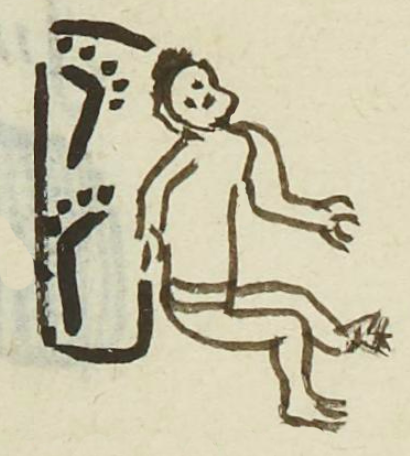Otlicahuetztoc (MH658r)
This black-line drawing of the compound glyph for the personal name Otlicahuetztoc ("He Lies Fallen By the Road") is attested here as a man’s name. It is a man in a 3/4 view, apparently sitting on the ground or on his back next to a road, having fallen. The fallen body suggests the verb huetzi and , and the road (otli) is shown as a vertical rectangle with two alternating foot prints (suggesting movement).
Stephanie Wood
The -toc suffix ("he is lying down"). The three-quarter view suggests European artistic influence. Some glyphs showing naked bodies--without even a loincloth--seem to show European influence, too. Many times they appear to be in vulnerable circumstances, such as this one, or Malteotl (MH832r), Tecuanitzin (MH532r), Cicuil (MH536r), Tlacatoncatl (MH641v), Motzetzelo (MH506v), and Tenapalo (MH551r).
Stephanie Wood
antoo otlicauetztoc
Antonio Otlicahuetztoc
Stephanie Wood
1560
Jeff Haskett-Wood
huellas, cuerpo, calles, caminos, caerse, caído, verbos, pretérito, torpe, nombres de hombres

o(tli), road, https://nahuatl.wired-humanities.org/content/otli
ica, with or through, https://nahuatl.wired-humanities.org/content/ica
huetztoc, to lie fallen, https://nahuatl.wired-humanities.org/content/huetztoc
James Lockhart (The Nahuas, 1992, 121) saw this personal name in the censuses of Culhuacan, c. 1580, and translated it as "He Lies Fallen On the Road."
Caído Junto al Camino
Stephanie Wood
Matrícula de Huexotzinco, folio 658r, World Digital Library, https://www.loc.gov/resource/gdcwdl.wdl_15282/?sp=396.
This manuscript is hosted by the Library of Congress and the World Digital Library; used here with the Creative Commons, “Attribution-NonCommercial-ShareAlike 3.0 License” (CC-BY-NC-SAq 3.0).




